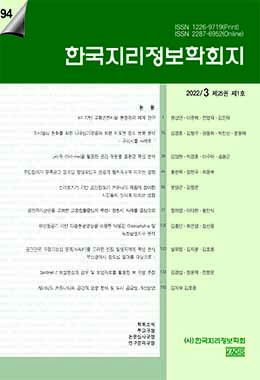본 연구는 커뮤니티 매핑 과정에 스마트기기로 수집된 공간분석 정보를 제공하고 공유하여 시민들이 자신의 의견을 객관적으로 검토할 수 있는 기회를 제공하고, 이러한 공간정보의 제공이 시민들의 의사결정과 인식에 어떤 영향을 미치는지를 살펴보았다. 연구를 위해 부산광역시 중구 영주동을 사례지역으로 선정하여 이 지역의 초등학생 보행안전 문제를 개선하기 위한 위험지역 선정을 목표로 커뮤니티 매핑을 진행하였다. 시민들은 자신들의 경험과 인식을 기반으로 1차 위험지도를 작성하고, 드론과 센서 등 스마트기기로 수집된 보행안전시설과 유동인구 공간정보를 공유한 후 2차 위험지도를 작성하였다. 1차, 2차 위험지도를 비교한 결과 많은 구간에서 순위 변동이 발생했으며, 참여주민들이 인식했던 것보다 객관적으로 측정된 유동인구가 많고 안전시설이 미비한 지역의 순위가 상향되었다. 또한, 주민 설문조사 결과를 살펴보면, 커뮤니티 매핑과정에서 스마트기기 기반 공간분석 정보의 제공은 시민들의 지역문제 인식에 도움을 주었을 뿐 아니라 본인들이 제출한 의견이 정책에 반영될 수 있을 것이라는 기대감도 증가시키는 것으로 나타났다. 또한 참여자들이 직접 만들어 낸 결과물에 대한 신뢰도 향상되어 주민 스스로 자신감과 믿음을 갖는데 도움을 주는 것으로 나타났다.
This study shared with community mapping participants spatial analysis information, collected using smart devices, to give them an opportunity to objectively review their opinions. The study examined the impact of sharing such spatial information on residents’ decision-making and perceptions. Yeongju-dong in Jung-gu district of Busan Metropolitan City, South Korea was selected for the case study; community mapping was carried out in Yeongju-dong to identify hazardous areas to improve pedestrian safety of primary school students. The community mapping participants drew a preliminary hazard map based on their experience and perception. Then, they drew a second hazard map after being given spatial information on pedestrian safety installations and pedestrian flow collected with smart devices including drones and sensors. Numerous changes in ranking across various sections occurred when the two maps were compared. There was a climb in the ranking of areas where the pedestrian flow was higher and lacked safety installations based on objective measurements over the perceptions of the participating people. Furthermore, according to a survey conducted among the participants, the provision of spatial analysis information using smart devices during community mapping process not only helped them recognize local community problems, but also raised their expectations that their submitted opinions would be reflected in policies. Moreover, the participants demonstrated increased self-confidence and faith in themselves as they were able to have more trust in the outcome they created.




